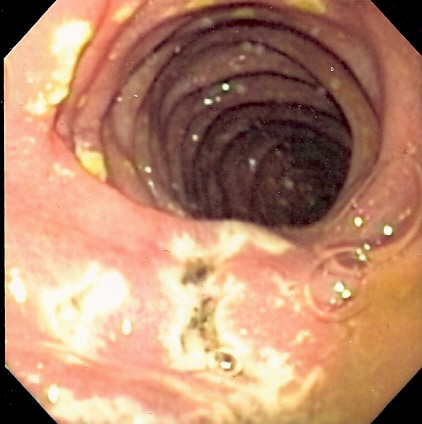Zollinger-Ellison syndrome
For patient information click here
Editor-In-Chief: C. Michael Gibson, M.S., M.D. [1] Phone:617-632-7753
Please Join in Editing This Page and Apply to be an Editor-In-Chief for this topic: There can be one or more than one Editor-In-Chief. You may also apply to be an Associate Editor-In-Chief of one of the subtopics below. Please mail us [2] to indicate your interest in serving either as an Editor-In-Chief of the entire topic or as an Associate Editor-In-Chief for a subtopic. Please be sure to attach your CV and or biographical sketch.
| Zollinger-Ellison syndrome | |
 | |
|---|---|
| Endoscopy image of multiple small ulcers in the distal duodenum in a patient with Zollinger-Ellison syndrome | |
| ICD-10 | E16.4 |
| ICD-9 | 251.5 |
| MedlinePlus | 000325 |
| eMedicine | med/2437 ped/2472 |
| MeSH | D015043 |
|
Zollinger-Ellison syndrome Microchapters |
|
Differentiating Zollinger-Ellison syndrome from other Diseases |
|---|
|
Diagnosis |
|
Treatment |
|
Case Studies |
|
Zollinger-Ellison syndrome On the Web |
|
American Roentgen Ray Society Images of Zollinger-Ellison syndrome |
|
Risk calculators and risk factors for Zollinger-Ellison syndrome |
Overview
Zollinger-Ellison syndrome is a disorder where increased levels of the hormone gastrin are produced, causing the stomach to produce excess hydrochloric acid. Often, the cause is a tumor (gastrinoma) of the duodenum or pancreas producing the hormone gastrin. Gastrin then causes an excessive production of acid which can lead to peptic ulcers (in almost 95% of patients)
Gastrin works on stomach parietal cells causing them to secrete more hydrogen ions into the stomach lumen. In addition, gastrin acts as a trophic factor for parietal cells, causing parietal cell hyperplasia. Thus, there is an increase in the number of acid secreting cells and each of these cells produces acid at a higher rate. The increase in acidity contributes to the development of peptic ulcers in the stomach and duodenum. High acid levels lead to multiple ulcers in the stomach and small bowel.
Patients with Zollinger-Ellison syndrome may experience abdominal pain and diarrhea. The diagnosis is also suspected in patients without symptoms who have severe ulceration of the stomach and small bowel, especially if they fail to respond to treatment.
Gastrinomas may occur as single tumors or as multiple, small tumors. About one-half to two-thirds of single gastrinomas are malignant tumors that most commonly spread to the liver and lymph nodes near the pancreas and small bowel. Nearly 25 percent of patients with gastrinomas have multiple tumors as part of a condition called multiple endocrine neoplasia type I (MEN I). MEN I patients have tumors in their pituitary gland and parathyroid glands in addition to tumors of the pancreas.
Symptoms
- epigastric pain (stomachache)
- vomiting blood (hematemesis) (occasional)
- difficulty in eating
- diarrhea
- steatorrhea
Diagnosis
The diagnosis of Zollinger-Ellison syndrome is made by several laboratory tests and imaging studies.
Laboratory tests:
- secretin stimulation test, which measures gastrin levels in response to secretin
- fasting gastrin levels
- antral acidity
Therapy
Proton pump inhibitors (such as omeprazole and lansoprazole) and histamine H2-receptor antagonists (such as famotidine and ranitidine) are used to slow down acid secretion. If possible the tumours should be surgically removed, or treated with chemotherapy.
Octreotide can be used to slow down acid secretion.
History
The disease entity was first described in 1955 by its namesakes: Zollinger RM, Ellison EH. Primary peptic ulcerations of the jejunum associated with islet cell tumors of the pancreas. Ann Surg 1955;142:709-23. PMID 13259432.
External links
de:Zollinger-Ellison-Syndrom sv:Zollinger-Ellisons syndrom th:โรคเนื้องอกที่เกิดจากการหลั่งกรดผิดปกติ